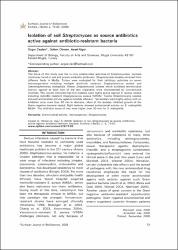Isolation of soil Streptomyces as source antibiotics active against antibiotic-resistant bacteria
Özet
Bu calismanin amaci toprakta yaygin olarak bulunan ve antibiyotik ureticileri olarak bilinen Streptomyces'lerin in vitro antimikrobiyal aktiviteleridir. Turkiye, Mugla'daki farkli alanlardan Streptomyces izolatlari, coklu antibiyotige direncli Staphylococcus aureus ve Stenotrophomonas maltophilia'yi kapsayan on bes mikroorganizma uzerinde inhibitor aktiviteleri degerlendirilmistir. Test mikroorganizmalarinin en az ikisine karsi antimikrobiyal aktivite gosteren on bes Streptomycete izolati geleneksel metodlar ile karakterize edilmistir. Sonuclar bes izolatin metisiline direncli Staphylococcus aureus (MRSA)'u kapsayan S. aureus suslarina karsi yuksek derecede aktif olduklarini gostermektedir. On iki Streptomycete izolati Candida albicans'a karsi antikandidal aktivite gostermistir. On izolat 30 mm captan daha fazla inhibisyon zonlu yuksek aktivitelidir. Izolatlarin cogu Gram negatif test bakterilerinin gelisimini inhibe etmistir. Sekiz izolat S. maltophilia MU64 uzerinde antibakteriyal aktivite gostermistir. Bunlarin ikisinin inhibisyon zonlari S. maltophilia icin 30 mm'den daha yuksektir. Abstract The focus of this study was the in vitro antimicrobial activities of Streptomycetes, bacteria commonly found in soil and known antibiotic-producers. Streptomycete isolates obtained from different fields in Mu& #240; la, Turkey were evaluated for their inhibitory activities on seven microorganisms including multiple antibiotic resistant Staphylococcus aureus and Stenotrophomonas maltophilia. Fifteen Streptomycete isolates which exhibited antimicrobial activity against at least two of the test organisms were characterized by conventional methods. The results indicated that five isolates were highly active against S. aureus strains including meticillin resistant Staphylococcus aureus (MRSA). Twelve Streptomycete isolates showed anticandidal activity against Candida albicans. Ten isolates were highly active with an inhibition zone more than 30 mm in diameter. Most of the isolates inhibited growth of the Gram negative bacteria tested. Eight isolates showed antibacterial activity on S. maltophilia MU64. The inhibition zones of two were higher than 30 mm for S. maltophilia.


















